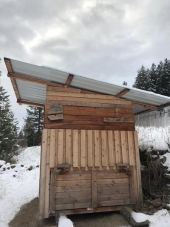
 2
2




 2
2




My books, movies, videos, podcasts, events ... the big collection of paul wheaton stuff!




[img]http://i109.photobucket.com/albums/n52/havlik1/permie%20pics2/permiepotrait3pdd.jpg[/img]
"One cannot help an involuntary process. The point is not to disturb it. - Dr. Michel Odent
 2
2












[img]http://i109.photobucket.com/albums/n52/havlik1/permie%20pics2/permiepotrait3pdd.jpg[/img]
"One cannot help an involuntary process. The point is not to disturb it. - Dr. Michel Odent















QuickBooks set up and Bookkeeping for Small Businesses and Farms - jocelyncampbell.com
 1
1








My books, movies, videos, podcasts, events ... the big collection of paul wheaton stuff!




















 1
1





 1
1








Jocelyn Campbell wrote:
Now I'm curious: Leah, did/does your turkey tractor have a house or shelter of some kind?
[img]http://i109.photobucket.com/albums/n52/havlik1/permie%20pics2/permiepotrait3pdd.jpg[/img]
"One cannot help an involuntary process. The point is not to disturb it. - Dr. Michel Odent
 2
2




 "Look at the bones!"
"Look at the bones!" 



 1
1








Valorie wrote:
I have to vouch for what Paul said, based on my experience: my rabbit doesn't burrow, and he is what I call "semi free-range". He used to be completely free range but was nearly carried off by a hawk, (he saved himself by darting under a hammock), so we cornered him under a large maple tree with about 150 square feet I think, and an underground shelter to hang out in. He's so happy (or lazy) that he has never burrowed in the 5 years we've had him.




 1
1




 It seems the kids were not watching our buck as much as they thought. The babies had the best room filled with soft angora fur, dry and very warm. They came through winter just fine. After this coming-out the babies would sleep in the small basket we used to carry hay into their area. They still wanted a round shape to curl up in.
It seems the kids were not watching our buck as much as they thought. The babies had the best room filled with soft angora fur, dry and very warm. They came through winter just fine. After this coming-out the babies would sleep in the small basket we used to carry hay into their area. They still wanted a round shape to curl up in.



 1
1




In Community,
Marilene Richardson
Director, SongCroft Self-Sufficiency Skills Apprenticeship Programs
www.songcroft.com
Subscribe to our newsletter!
http://bit.ly/Newsletter_Page
Follow us on Twitter and Facebook




Yes. Pastured rabbits are different to farmed colonies. And in terms of farmed colonies there seem to be many variations. I have been a member of the colony raising rabbits forum on yahoo for some time now and even those who have just an extensive run for their rabbits consider it "colony" because the rabbits run free.Jami McBride wrote:
Pastured rabbits are very different from colony raised rabbits (this is the correct term). Pastured rabbits are in cages on the ground that are moved around on pasture, these cages have bottoms of wire. While Colony raised rabbits are in an enclosed area of several square feet. They are allowed to dig their burrows. When raised this way, with burrow, from birth they don't tend to dig out. The burrows have several entrances/exits all within the enclosure.




 1
1













 1
1












 1
1













Nice link. Thank you. Interesting too about chicken poop and rabbits. Will watch for that then.Jami McBride wrote:
Great info! Your right about people calling any situation on dirt a colony now days. I consider a colony when the rabbits are allowed to form colonies and create their own housing.
Your plan to pasture the rabbits for health is a good idea, seems continuous moving of animals, as Joel Salatin does is the best way to prevent many diseases.
Here are some reference links for colonies -
http://www.homesteadingtoday.com/showthread.php?t=93394 You can click on the link in a post for some great pictures if I remember right.
http://www.thefreelibrary.com/Raising+rabbits+in+colonies.-a0111897693 "I also add a little apple cider vinegar to their water daily as a coccidiosis prevention".
Good points Permie mama, thanks for adding your insight.
I also want to mention the 'official' warning that rabbits can get diseases when exposed to bird feces's (chicken/duck) and cow feces's. I allow my rabbits to run free in my backyard during the summer, along with the birds and so far no problems. I also disperse the feces, blasting with water, on a regular bases so the soil gets the fertilization and the surface is free of poo-piles. This in effect cleans anything the rabbits might want to munch on, I believe therein is where the contamination of rabbits occurs.
This first picture below is of our winter setup - the rabbits have tunnels into the hay and under into the ground. We feed and water above. This pic was taken in early spring before I have recycled the hay and many of the plants have sprouted back. Most of the rabbits are in the tunnels.... The 'door' in is at the back of the dog kennel which has no bottom. The kennel has a top shelf which I put a square of carpet on so the rabbits feet don't fall through.
Dog kennels are/were much much cheaper than rabbit hutches
Our theory is a few rabbits offer human-enrichment.....









composter wrote:
For protection from predators, wouldn't an LGD be a good idea? I have known many rabbit/dog friendships, so don't know why you couldn't raise a dog to be a rabbit guardian - carefully of course.

|
He's giving us the slip! Quick! Grab this tiny ad!
turnkey permaculture paradise for zero monies
https://permies.com/t/267198/turnkey-permaculture-paradise-monies
|




